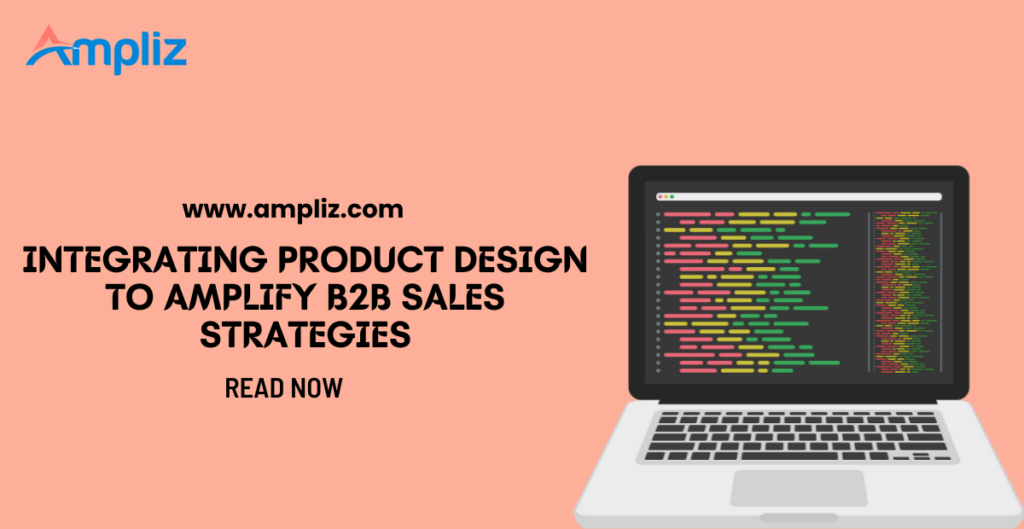Nowadays, B2B product design is critical to any business. Integrating product design can boost B2B sales strategies. When we say B2B product design, it is the method of designing the product for business operations, including software and supplies.
Its goal is to streamline purchasing procedures to please clients and provide a massively important solution. B2B designs ought to stick to the consumer’s business plan.
Product design companies create solutions by providing tools that simplify business processes and designing products that meet the needs of business customers.
Integrating B2B product design into your business may boost your business-to-business sales strategies and help your company grow to its full potential.
This post emphasizes the importance of product design to businesses, the rules of B2B design, aspects to consider, and significant topics.
The Importance of B2B Product Design to Business
In today’s digital world, product design is essential to stay relevant in the market, and B2B design can help boost your B2B sales strategies. This section will discuss the significance of B2B design to businesses.
Unique designs can create sales.
Having clean, concise, and simple designs for your business website and other products can attract buyers and increase revenue.
If your website or app is user-friendly, displays easy-to-understand text, and is simple to navigate, customers will love to visit your website, use your software, and purchase your products.
Not only that, but they will spread the word by recommending your product to others and leaving positive feedback or reviews on your website.
Add value to your business offerings.
Business-to-business design adds value to your products or services. B2B design can add value to every product your company sells.
Because product design is derived from extensive research, analysis, and customer planning, your business will develop quality products and provide value to your customers. It may enhance customers’ satisfaction over time.
Buyers and users will pay more for functional, sustainable, and visually appealing products.
Enhance your business operations.
Product design companies provide B2B tools to help business operations and workflows streamline the process. These solutions include automation tools for websites and workflows.
A well-design app is helpful for users to maximize the potential of the software to boost workflow and business efficiency.
Design solution provides an intuitive onboarding process ensuring that employees use the tool confidently, increasing the business’s productivity and ROI.
It can automate your internal operations, which increases business productivity and efficiency. And make your selling process more efficient and fast, which satisfies users’ experience.
Cost-saving
One example of a B2B solution is designing eCommerce channels where trading products and services on the internet are efficient and fast. I
t can lower operating expenses because the business process is automated and reduces the need for human intervention when processing orders, managing inventories, etc. Businesses can save money and time in the long run.
Streamline the selling and buying processes.
B2B models involve software and tools. All the selling and buying operations are automated, reducing delays and errors in the transactions and processes. Businesses can track, monitor and ship goods in quick and fast transactions.
Enhance customer relationships
Effective B2B design improves customer experience and builds customer trust by continuing to provide value. Brands can improve customer relationships by providing accessible information and transparency, leading to more loyal customers in the future.
Enhance visibility
B2B design solutions transform brand visibility through websites and social media platforms. The technology gives businesses greater visibility and data analytics, allowing companies to manage products more efficiently and access global markets.
Build a strong brand for your business.
A robust B2B brand design distinguishes your product from the competition, giving buyers a reason to choose your brand over others. It enables you to build trust with your stockholders, employees, customers, distributors, and more.
B2B Product Design Strategies
The strategies discussed in this post apply to all interfaces striving to convert sales, not just B2B. So consider which sections should be prioritized to help increase your business revenue.
Build up the visual performance.
Graphics and website content are essential visual elements. Increasing your visual performance by using design techniques can boost your visual performance.
Avoid overwhelming users with information and large amounts of data, which may impact your website’s performance. Too much content, such as videos and large imagery, may confuse and irritate visitors.
Placing too many content materials may cause your page to become unreadable and cluttered. There’s a correct implementation of visual hierarchy and the site’s functionality to ensure users have a pleasant visit.
Make the value proposal stand out.
Creating catchy headlines or enticing slogans about what your brand stands for or your products are a great way to entice customers to learn more about your product. Include the right fonts, colors, and typographic hierarchy; the company’s policies and brand should be consistent.
The call to action should be visible.
B2B websites are tools for generating leads, and it is essential to design them according to the business goals. The CTAs should adequately address, making it visible to visitors what you’re selling and your intent to convert them into potential buyers.
CTAs, or call-to-action buttons, should be visible and easily identifiable to capture consumers and drive sales. For your CTAs to be clickable, use appropriate colors, orientation contrast, shape, and background. It significantly impacts conversion rates and may help increase your ROI.
Create copy digestible
Crafting Copy content for your brand websites significantly impacts business conversion. Know why you’re writing the copy, whether long or short. You should know when to write a long or short copy to attract buyers. Remember to make it exciting and easy to read.
Long-form copy is for new products or services that require more promotional information to persuade and capture buyers or users. Short copies are intended for well-known products or to inform customers of special offers. The copy should be easy to digest and read by visitors of all types and provide helpful information to the readers.
Security is vital
Your business website should have an SSL certificate to secure your web and safeguard all information or users’ data. Product design focuses on quality and performance and should ensure customers’ and business data to the maximum level, especially in financial industries.
Apply color psychology
Color psychology involves colors influencing emotional responses influenced by age and cultural background. For example, if your brand is aimed at Gen Z, you’ll need to use colors that appeal to millennials of a certain age. And if your brand voice represents wisdom or hope, you’ll need to incorporate blue into your displays.
Clients’ testimonials and the company’s achievements
Display client testimonials and company trophies or awards on your website to make a good impression on your customers. Good reviews and business accomplishments should combine to add value and brand identity to your company.
Business contact information is clickable.
The business details or contact information are presented in various formats, but remember to make them clickable. Emails, phone numbers, business addresses, social media channels, and more are all included.
According to statistics, nearly 7 million mobile subscribers worldwide, most of whom use their phones to browse online products. Your displays must also be mobile-friendly to capture mobile users and reach more web customers.
The b2b solution should align with extensive research targeting audience needs while providing a convenient way to contact your company.
Benefits of Using Product Design on Business
Integrating design into your business can reap multiple advantages. It improves business efficiencies and performance, which is one of the benefits your company may gain.
Using design in your company or business may benefit you in the following ways:
- Increase your company’s sales.
- Boost market position
- Reducing user complaints
- Develop customer service and increase customer loyalty.
- It strengthens brand identity and raises brand awareness.
- Open the door to new business product innovations and services, as well as new markets and global access.
- Expand market compliance and product quality.
There are several advantages of product design in business. It generates sales, adds value to the company, streamlines operations, strengthens brand identity and reputation, increases product visibility, and many more.
Things to Consider When Integrating B2B Product Design
Design solutions should align with business goals, and it comprises many aspects:
Strengthen the business branding and policy.
The design solutions should have strong branding consistent with the company’s policies. With a friendly user interface, the design should match the customer’s needs.
From user interaction to visual perception, the app design, including the website and other portals, should present the company’s brand as professionally as possible.
It necessitates greater cooperation between the business and the designers to conduct market research and understand the company’s identity and brand reputation.
Acknowledge users
Designs that acknowledge users satisfy users’ experience. It understands their pain points and needs which can create good relationships with your clients and loyal customers in the long run.
The design should be consistent.
Social networks are essential for marketing strategy. Design elements should be consistent with the company’s voice, brand, social networking sites, graphics and colors, items, and so on.
The B2B design should be consistent across the website, including the headers, elements, logo design, and other social media images. The brand becomes recognizable, strong, and visible, representing the company’s identity.
Keep business relationships
There are several important factors to consider when developing a great B2B design solution:
- Recognize and address the customer’s pain points.
- Collect client feedback through extensive research and understanding.
- Meet user demands and requirements through product performance and quality.
- Produce simple, simple products, provide solutions, and meet their needs.
- Create functional and user-friendly websites and apps.
- Maintain excellent and clear communication with customers to foster trust.
Minimalistic and concise
In B2B design, minimalism features simplicity, clean, concise texts, and layouts. It eliminates unnecessary elements such as flashy elements and bolder fonts, making it aesthetically pleasing to attract more customers and visitors.
Concise texts and information displayed on websites or apps promote better user experience and enhance customer relationships with your brand.
How to Use Product Design to Improve Your B2B Marketing?
Improving your design is vital to earning a good impression on your potential business partners. Here are some pointers on how to use design to strengthen your B2B marketing.
Focus on the website’s design.
When you post B2B ads on social media, potential customers are likelier to click on them, directing them to your company’s website. Visitors will fail to convert and leave if your website is not engaging in seconds. Here are the key areas that need improvement:
- Use a consistent logo across all channels to strengthen brand recognition, including color palettes and fonts.
- Ensure your website is easy to use and looks good on mobile and desktop devices.
- Try creating beautiful landing pages and link instead to your homepage.
Integrate multimedia and motion design
Multimedia is crucial in digital marketing. Here are some pointers for creating great multimedia designs:
- Add an on-text screen or subtitles to your video.
- Post an explainer video to attract business leaders or managers.
- Ensure to use multimedia formats playable for mobiles to capture a wider audience.
- Scalable design elements, such as branding, animations, and so on, should be used in your videos, especially in marketing materials.
Conclusion
Because of its complexity, B2B design is more broad than B2C design. It includes specific features and functions. In B2B applications, user experience is the top priority for user onboarding, influencing the app’s adaptation and success in the industry.
Based on user feedback and company requirements, B2B design necessitates ongoing analysis and improvement. Designers can build a product that is marketable and valuable to users. And can produce effective products that meet their customers’ needs by emphasizing best practices and employing user-centric design procedures.
Effective product design necessitates careful implementation, extensive research, brand consistency, integration with other tools, data analytics, and other factors to amplify B2B sales strategies.
In addition, product design companies can create a product that meets users’ needs and helps businesses achieve their goals more effectively by employing the best approaches in every aspect.
Furthermore, collaboration with the company increases the efficiency and effectiveness of the marketing effort in achieving business success.



